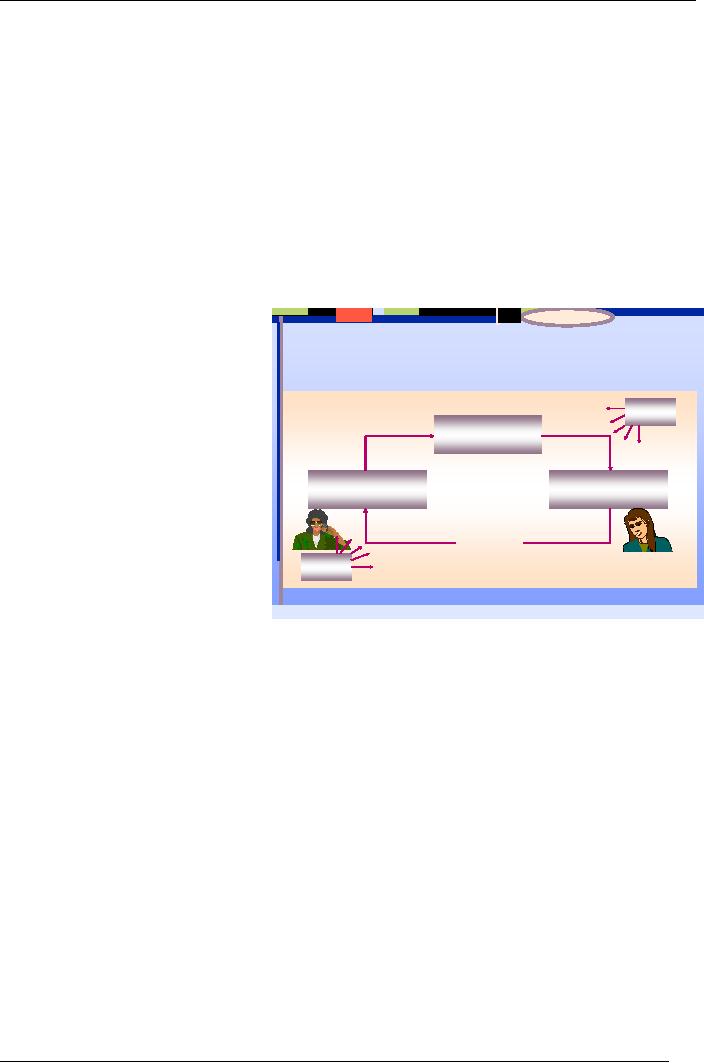 |

Human
Resource Management
(MGT501)
VU
Lesson
34
COMMUNICATION
IN ORGANIZATION
After
studying this chapter, students should be
able to understand the
following:
A.
Explain Burnout
B.
Describe Communication in
Organization
LESSON
OVERVIEW
This
chapter also presents a model of
how communication works. Moreover, it
explores specific
policies
that
give employees access to important
company information as well as
those which provide feedback
to
top
managers.
A.
Burnout
Burnout
is a pattern of emotional, physical, and
mental exhaustion in response to chronic
job stressors. It is
an
incapacitating condition in which
individuals lose a sense of the
basic purpose and
fulfillment of their
work
Burnout
has been described as a
state of fatigue or frustration that
stems from devotion to a
cause, way of
life,
or relationship that did not
provide the expected reward. It is
often found in a midlife or
mid-career
crisis,
but it can happen at
different times to different
people. Individuals in the helping
professions such as
teachers
and counselors seem to be
susceptible to burnout, whereas
others may be vulnerable because
of
their
upbringing, expectations, or their
personalities. Burnout is frequently
associated with people
whose
jobs
require close relationships with others
under stressful and tension-filled
conditions. The dangerous
part
of
burnout is that it is contagious. A
highly cynical and
pessimistic burnout victim
can quickly transform an
entire
group into burnouts. It is important to
deal with it quickly; once
it has begun, it is difficult to
stop.
I.
Symptoms of Burn-Out
Following
symptoms indicate that a person is
suffering through burnout
∑
A feeling of
lack-of-control over
commitments
∑
A
belief (incorrect) that you
are accomplishing
less
∑
A
growing tendency to think
negatively
∑
Loss
of a sense of purpose and
energy
Family
Organizational
∑
Increased
detachment from relationships
Spouse,
Children
Supervisor
Parents,
In-laws
Colleagues
II.
Avoiding Burn-Out
Subordinates
Burnout
can be avoided by taking the following
steps
Clients
∑
Re-evaluate
goals
Religion
Individual
∑
Reduce
unnecessary commitments
Alams,
Teachers
Friends
∑
Learn
stress management
skills
Support
groups
∑
Find
out where the stress is coming
Professional
from
(family, job, etc.)
Physicians
∑
Follow
a healthy lifestyle
Clubs
Psychologists
Counselors
∑
Get
adequate rest
Business
associations
Lawyers
Social
clubs
∑
Eat
a balanced diet
Athletic
groups
∑
Get
regular exercise
∑
Limit
caffeine and alcohol
∑
Develop
other interests
(hobbies)
∑
Acknowledge
your humanity--you have a
right to pleasure and
relaxation
Social
Support at Work &
Home:
Social
support at home by friends family
members and at workplace by supervisor,
colleagues subordinates
etc
can be used to avoid the
burnout in the organizations.
151

Human
Resource Management
(MGT501)
VU
B.
Communication in organization
The
transmission of information and
understanding through the use of common
symbols is termed as
communication.
Communication is the exchange of information
between people; it occurs
when one
person
understands the meaning of a message
sent by another person, and
responds to it. Two forms
of
information
are sent and received in
communications: facts and
feelings. Facts
are
pieces of information
that
can be objectively measured or
described. Examples are the
cost of a computer, the daily defect rate
in
a
manufacturing plant, and the size of the
deductible payment of the company-sponsored health
insurance
policy.
Feelings
are
employees' emotional responses to the
decisions made or actions
taken by managers or
other
employees. Organizations need to
design communication channels that
allow employees to
communicate
facts and feelings about
specific aspects of their
jobs.
I.
The Communication Process
Communication,
a continuous process, is the exchange of
information and meaning
between people. It
occurs
when one person understands
and responds to the meaning of a
message sent by someone
else. The
communication
process includes five
main
components: the information
source,
the signal, the transmission, the
The
Communication Process
destination
or receiver, and the
noise.
within
an Organization
Communication
starts with a sender
who
has a message to send to
the
receiver.
The sender must encode
the
Noi
se
Communication
message
and select a communication
Channel
channel
that will deliver it to
the
receiver.
In communicating facts, the
Sender
Receiver
message
may be encoded with
words,
(Encode
s Me ssage)
(Decode
s Me ssage)
numbers,
or digital symbols;
in
communicating
feelings, it may be
encoded
as body language or tone
of
Feedback
voice.
Noi
se
Communications
that provide
for
feedback
are
called
two-way
communications
because they allow the
sender
and receiver to interact with
each other. Communications
that provide no opportunity
for feedback
are
one-way. Noise means
barriers to effective Communication. Potential
barriers include: ambiguous,
muddled
messages; semantics; physical
barriers; loss of transmission;
failing to communicate;
competition
barriers;
cultural, linguistic, and diversity barriers;
and not listening.
II.
Nonverbal Communication
Nonverbal
communication is the non-spoken aspects of communication,
such as a person's manner
of
speaking,
facial expressions, or body
posture, that express
meaning to others. The
nonverbal aspects of
communication
can especially complicate the
task of communicating internationally.
Nonverbal
communication
is communication that is sent without the
use of the written or spoken
word. This type of
communication
is quite powerful because people
can communicate without
speaking through the use
of
facial
expression, body posture,
tone of voice, use of space,
and touching. Occulesics are
facial expressions
and
eye contact that people use
to communicate. Kinesics is the study of
bodies through posture,
gesture,
head
movements, and similar
actions. Use of and reaction to
facial expressions and body
movement vary
from
culture to culture.
III.
Barriers to Effective Communication and
ways to remove these
barriers
The
complex factors in the communication pose
barriers to effective communication. Individual
barriers
include
perceptual biases, which
function as noise by affecting how the
receiver gathers, organizes,
and
interprets
information. Organizational barriers to effective
communication include organizational culture
and
structure, status differences,
and time.
Active
listening is a good way to minimize both
individual and organizational barriers to
effective
152

Human
Resource Management
(MGT501)
VU
communication.
In active listening, the receiver assumes
a conscious and dynamic role
in the
communication
process through a variety of behaviors
and actions. Both the sender
and the message are
targets
for the active listener. Cultural
differences can influence active
listening.
Feedback
is information about some
behavior and its effect.
Managers need to provide
feedback to
employees
about their job performance; they
also give feedback to suppliers
and customers about
various
matters.
Managers often have
difficulty giving negative
feedback--just as employees tend to stop
actively
listening
to negative feedback. Therefore, effective
feedback should be fact-based, timely,
and focused on
behaviors.
Feedback is another part of communication
that is affected by cultural differences.
Supportive
communication
is honest, accurate interpersonal communication
that focuses on building and
enhancing
relationships.
There are number of attributes of supportive
communication, which aims to create
an
environment
in which people can openly
exchange information about
issues.
A
number of interpersonal and intrapersonal barriers
effect the decoding of a message.
Filtering
refers to manipulating information so
that it will be received
more favorably.
Filtering
is most likely to occur
where there is emphasis on
status differences and
among
employees
with strong career mobility
aspirations.
Expect
more filtering taking place
in large corporations than in small
business firms.
With
selective perception, receivers see
and hear based on their
needs, motivations, experience,
background,
and
other personal
characteristics.
Information
overload happens when individuals have
more information than they
can sort out and
use; they
tend
to select out, ignore, pass
over, or forget information,
etc.
Emotions.
When people feel that they're being
threatened, they tend to react in
ways that reduce their
ability
to
achieve mutual understanding.
Language.
The meanings of words are
not in the words; they are in
us.
Employees
come from diverse
backgrounds and have
different patterns of
speech.
Grouping
of employees into departments
creates specialists who develop
their own jargon
or
technical language.
While
we speak a common language--English-our usage of
that language is far from
uniform.
The
problem is that members in an
organization usually don't know
how others with
whom
they interact have modified the
language.
An
estimated 5 to 20 percent of the
population suffer from debilitating
communication apprehension or
anxiety.
People
who suffer from it experience undue
tension and anxiety in oral
communication,
written
communication, or both.
Studies
demonstrate that oral-communication
apprehensives avoid situations
that require them to engage in
oral
communication.
Of
greater concern is the evidence
that high-oral-communication apprehensives
distort the communication
demands
of their jobs in order to minimize the
need for communication.
IV.
Improving Communication in
Organizations
Working
with supervisors and
managers, employee relations
representatives can facilitate
effective
communications
by developing and maintaining three
types of programs: information
dissemination,
employee
feedback, and employee
assistance.
a.
Information Dissemination
Programs
Information
dissemination involves making information
available to decision makers,
wherever they are
located.
The employee handbook is
probably the most important
source of information the HR
department
can provide and sets the
tone for the company's
overall employee relations philosophy.
There
are
many other forms of written communication
besides the employee handbook
that can be used to
alert
employees
to important information. These include
memos and
newsletters.
1.
The
employee handbook
2.
Written
communications: memos, financial
statements, newsletters, and
bulletin boards
3.
Audiovisual
communications
153

Human
Resource Management
(MGT501)
VU
b.
Electronic Communications
New
technologies have made it
possible to disseminate information
that goes beyond the printed
word.
Visual
images and audio information
are powerful communication tools. A
recent technological advance,
teleconferencing,
allows people with busy
schedules to participate in meetings even
when they are a great
distance
away from the conference
location (or each other).
Advances in electronic communications
(voice
mail
and e-mail) have made
interactive communications between sender
and receiver possible even
when
they
are separated by physical
distance and busy
schedules.
c.
Meetings
Formal
meetings are opportunities
for face-to-face communication between
two or more employees and
are
guided
by a specific agenda. Formal meetings
facilitate dialogue and promote the
nurturing of personal
relationships,
particularly among employees who
may not interact frequently
because they are separated
by
organizational
or geographic barriers.
Retreats
Informal
communications
d.
Employee Feedback Programs
To
provide upward communications channels
between employees and
management, many
organizations
offer
employee feedback programs.
These programs are designed
to improve management-employee
relations
by giving employees a voice in decision
making and policy formulation
and by making sure
that
they
receive due process on any
complaints they lodge against managers.
The most common
employee
feedback
programs are employee
attitude surveys, appeals
procedures, and employee
assistance programs.
Employee
attitude surveys
Appeals
procedures
e.
Employee Assistance Programs
EAPs
help employees cope with
personal problems that are
interfering with their job
performance. These
problems
may include alcohol or drug abuse,
domestic violence, elder care,
AIDS and other diseases,
eating
disorders,
and compulsive gambling.
Confidentiality is an important component of
these programs.
V.
The Formal and Informal
Communication
a.
Formal communication networks
-
Networks that are designated
by the organizational
structure,
charts, or other official
documents.
b.
Informal Communications
Informal
communication flows outside of the firm's
chain of command.
How
Excellent Companies Foster Informal
Communications
The
following techniques have
been found to encourage
informal communication: 1)
emphasizing
informality;
2) maintaining an extraordinary level of communication intensity;
and 3) giving communication
the
physical support. Management
by Wandering around: The
communication skill here is not in
the
wandering
around the office, but in the interpersonal
communication skills you can
bring to bear when
you're
speaking with the employees.
These skills include paying attention,
making yourself clear, listening
actively,
and listening sympathetically.
VI.
Levels of Communication
a.
Upward Communication
Upward
communication from subordinates to
superiors provides management with
valuable insight into
how
the organization is functioning, and provides
superiors with feedback
about whether subordinates
understand
orders and instructions. It gives
employees an opportunity to vent
their feelings.
Upward
communication
can be encouraged by social
gatherings, union publications, regular
meetings, performance
appraisal
meetings, grievances, attitude
surveys, a suggestion system,
and open door policy,
indirect
measures,
and email. Formal, comprehensive
programs and upward appraisals
also encourage upward
communication.
When
communicating with a supervisor, avoid
phrases that may
inadvertently signal a lack of
responsibility
on
your part. Avoid counterproductive
body language and nonverbal
mannerisms.
154

Human
Resource Management
(MGT501)
VU
b.
Downward Communication
Downward
communication is transmitted from superior to subordinate on
subjects like corporate
vision
and
mission, what the job consists
of, performance evaluations,
job instruction, and organizational
policies
and
practices. This format can
help build commitment by keeping
employees informed about what the
organization
plans to do. Some firms install
open-book management programs
that manage without
concealment,
and motivate all employees
to focus on helping the business grow
profitable and
increasing
the
return on it human capital.
Open-book management fosters trust
and commitment among
employees
by
treating them more like
partners.
When
communicating with subordinates, remember
that fairness and the
appearance of fairness are
key.
Make
sure your body language
comes across as open and
receptive.
c.
Horizontal Communication
Horizontal
or lateral communications are
messages between departments or people in
the same department.
Managers
use individuals or committees to bridge
departments and improve the
flow of communication
between
them by using liaison personnel,
committees and task forces,
and independent integrators.
VII.
Communications and HRM
HRM
depends upon the effective communications
systems in the organization for its
success because all
its
functions
like staffing , compensating ,
performance appraisal, training
and development , etc require
communication
system for their executions
basic purposes that are
served through communication
systems
are
keeping employees informed using it a s a
tool to bring about positive
change and to Influence
culture.
Bulletin
board, newsletter and gossip
are different sources that
are used to disseminate
information in the
organizations.
Employees
are provided with the Employee
Handbook which serves many
purposes like (1) it
helps
employees
learn about company at their
own pace. (2) Provides
references regarding policies,
rules, and
benefits.
(3) Ensures HRM policies
will be consistently applied. (4)
Creates sense of security
and
commitment
for employees. (5) Provides
information to recruits. (6)
May be interpreted as implied
contract.
(7)Should
be updated continually but the
important thing is that
these purposes can be
achieved only if the
employee
handbook is Well Organized, Clearly
Written and legally limited.
Employee handbook mainly
includes
the information both about the
employee and employer for
employee it provides information
regarding
the job description and for employer it
provides information about the rules
regulations of the
organization
and different compensation benefits
etc related information to the
employees.
VIII.
Communication Methods
Inside
the organization Employee handbook, Bulletin board,
Company newsletter, Company-wide
meetings,
Digital Media etc are
used as source or method to
communicate while for the
offsite employees
facsimile
machine, E-mails, and
Internet Phone are used as
tools for communication of
information,
Key
Terms
Burnout:
An
incapacitating condition in which
individuals lose a sense of the
basic purpose and
fulfillment
of
their work
Communication
Exchange
of information between people; it
occurs when one person
understands the
meaning
of a message sent by another person,
and responds to it.
Noise: All
factors that interfere with
and distort communication.
Encoding:
Process
by which sender puts a
message in a certain format to
send to the receiver.
Feedback::
Information about some
behavior and its
effect.
Decoding:
Process by which the receiver
translates the sender's message
into an understandable
form.
155
Table of Contents:
- INTRODUCTION TO HRM:Growing Importance of HRM, Road Map of the Course
- ESSENTIALS OF MANAGEMENT:Concepts and Essential of Management, Managerís Roles
- ORGANIZATION AND COMPONENTS OF ORGANIZATION:Open versus Closed Systems, The Hawthorne Studies
- PEOPLE AND THEIR BEHAVIOR:Why to work in organizations?, The Goals of Organizational Behavior
- INDIVIDUAL VS. GROUP BEHAVIOR:What Are Roles?, Problem solving Team
- PERSONNEL MANAGEMENT TO HUMAN RESOURCE MANAGEMENT:Records and Administration, Competitive Advantage
- HRM IN A CHANGING ENVIRONMENT:Productivity, New Trends at Work Place
- How organization Cultivate a Diverse Workforce, STEPS TOWARD MANAGEMENT OF DIVERSITY
- FUNCTIONS AND ENVIRONMENT OF HRM:Compensation and Benefits, Safety And Health, Interrelationships of HRM Functions
- LINE AND STAFF ASPECTS OF HRM:Authority, Line versus Staff Authority, Staff Manager
- LEGAL CONTEXT OF HR DECISIONS:Doing the Right Thing, Affirmative Action, Unintended Consequences
- HUMAN RESOURCE PLANNING (HRP):Benefits of HR Planning, Forecasting Human Resource Availability
- STRATEGIC PLANNING AND HRIS:HRís Strategic Role, Human Resource Information System, Common HRIS Functions
- JOB ANALYSIS:Purposes of the job Analysis, Questions Job Analysis Should Answer
- JOB ANALYSIS:Methods of Collecting Job Analysis Information, Observation, Source of Data
- JOB ANALYSIS (CONTD.):SURPLUS OF EMPLOYEES FORECASTED, Diversity through Recruiting Efforts
- SOURCES OF RECRUITMENT:ALTERNATIVES TO RECRUITMENT, Quantity of the Applicants, Quality of the Applicants
- SELECTION:Initial Screening, Advantages of Successful Screening
- SELECTION TESTS:Characteristics of Properly Designed Selection Tests, Guidelines for Conducting an Interview
- SELECTION PROCESSÖ CONTD:Background Investigations, Physical Exam, Selecting Managers
- SOCIALIZATION:Compensation and Benefits, Team Membership, Stages in socialization Process, Training and Development Trends
- TRAINING AND DEVELOPMENT:Learning, Phases of Training, Why Transfer of Training Fails
- MAXIMIZING LEARNING:Following up on Training, Repetition, Feedback, Purposes of T & D
- CAREER MANAGEMENT:Individual career planning, Career Planning and Development Methods
- PERFORMANCE:Determinants of Job Performance, Why is performance measured?, Performance Management
- PERFORMANCE APPRAISAL:What to Evaluate, The Appraisal Interview, PROBLEMS IN PERFORMANCE APPRAISAL
- JOB EVALUATION AND PRICING:THE APPRAISAL PERIOD, Ranking method,
- COMPENSATION SYSTEM:Pay, Job Pricing, Compensation: An Overview, Compensation Surveys
- BENEFITS:Total Compensation, Discretionary Benefits (Voluntary), Workplace Flexibility
- ROLE OF MONEY IN PERFORMANCE OF EMPLOYEES:Types of Pay-for-Performance Plans, Empower Employees
- MOTIVATION:The Motivation Process, Motivational Theories, Challenges of motivating employees
- OCCUPATION, HEALTH & SAFETY:Physical Conditions, Accident Investigation, Smoking in The work place
- STRESS MANAGEMENT:Symptoms of Stress, Managing Stress,
- COMMUNICATION IN ORGANIZATION:Burnout, Social Support at Work & Home, Communication in organization, Meetings
- TRADE UNIONS:Collective Bargaining, The HRM Department in a Nonunion Setting, Phases of Labor Relations
- CONFLICT AND NEGOTIATION:Transitions in Conflict Thought, Individual Conflict Management Styles
- POWER AND POLITICS:Sources of Power, Advantages and Disadvantages of PowerPower and Politics in Context
- EMPLOYEE RIGHTS AND DISCIPLINE:Contractual Rights, Management Rights, Disciplining Employees,
- DISCIPLINE (CONT...):Factors to Consider when Disciplining, Disciplinary Guidelines, Employee Separations
- LEADERSHIP:The Leaderís Behavior, Situational Theories of Leadership, Becoming a Leader
- REVISION (LESSON 12-21):Plans, Job Specification, Human resource planning, Selection Process, Corporate Culture
- REVISION (LESSON 22-26):Training, Case Study Method, Training, Performance
- REVISION (LESSON 27-35):Classification Method, Compensation, Empowerment, Mediation
- INTERNATIONAL DIMENSIONS OF HRM:Global Corporation, Type of staff members, Approaches to Global Staffing
- CONCLUSION & REVIEW:Strategies for Gaining Competitive Advantage, High-performance Work System